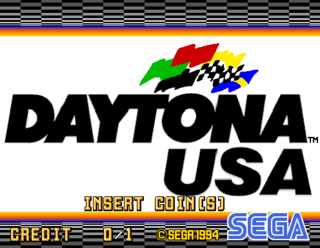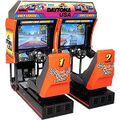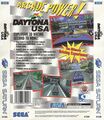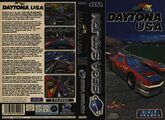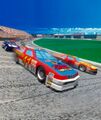Daytona USA
From Sega Retro
| Daytona USA |
|---|
| System(s): Sega Model 2, Sega Saturn |
| Publisher: Sega |
| Developer: Sega AM2 |
| Genre: Racing |
| Number of players: 1-8 1-2 |
Daytona USA (デイトナUSA) is a Sega Model 2 arcade racing game developed by Sega AM2. It was initially released in Japan in 1993, before making an international release a year later. It is loosely based on the NASCAR racing event at the Daytona International Speedway, located in real life in Daytona Beach, Florida in the United States of America. Daytona USA and all of its sequels leading up to Sega Racing Classic have been officially sponsored by the International Speedway Corporation.
The original arcade release has the player drive a stock car, known as the "Hornet" (number 41) loosely based on a Chevrolet Beretta, racing against numerous other cars around three selectable tracks. Player one's car by default is coloured red and blue (the manual car uses a red, black and yellow colour scheme), and can be seen at the forefront of all game covers, flyers and similar media related to the series with the exception of Daytona USA 2 and its update, Daytona USA 2: Power Edition.
The game features both automatic and manual transmissions, the latter requiring use of the gear stick and which, if used properly, can lead to a faster car than the automatic. Crashing into walls or other cars can inflict damage leading to poor performance - to remedy this each level has a pit lane, which, by sacrificing some time, can fix the car.
Daytona USA's original arcade release was notable for a number of reasons. At the time, it was considered perhaps the most detailed 3D racing game ever created. Though it had a lower polygon count than Sega's previous creation Virtua Racing (released in 1992), the 3D world was fully texture-mapped, giving the impression of a more realistic world. Coupled with this, Daytona USA is able to keep a constant full 60FPS refresh rate, even with multiple on-screen opponents.
However Daytona USA is famous mainly for its multiplayer features. It was the first arcade game ever to allow up to eight cabinets to be linked together, with each player capable of competing in the same race. Each player assumes the roll of a different coloured Hornet, and each cabinet must be ready to race and agreed on a course before this can happen (otherwise the game may start up with less than eight players).
The soundtrack was composed and performed by Takenobu Mitsuyoshi, however in the Model 2 version he does not sing entire songs at once. Instead parts of his vocals were recorded and played at various pitches and lengths in order to construct songs, hence their arguably simplistic nature. This is because Model 2 hardware has comparitively limited sound capabilities compared to systems which rely on CD audio.
The game also has Team Hornet inform the player of turns and traffic, and will comment on your driving if you crash.
The 1994 western release has slightly better AI than the 1993 Japanese original, but is otherwise identical. Other revisions of the game involve advertisements for the Sega Saturn.
Contents
Tracks
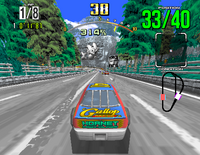 |
The beginner track, Three-Seven Speedway (or 777 Speedway), is the simplest and most iconic track of the series, built similarly to real NASCAR tracks and is loosely based off of the Pocono Speedway in Pennsylvania. It is essentially a circle, which by default has the user race 8 laps against 39 other cars. Notable features include a cliff face with Sonic the Hedgehog ingraved into the side. It is the only track in the game to offer a "rolling start". In the original Model 2 version of the game, tracks were not given names. It was only subsequent ports (and the official Daytona USA soundtrack) which named them.
Three-Seven Speedway contains strange slot machine banners, which can be manipulated by pressing the START button. Getting three 7s will give you seven seconds of extra time, with three BARs giving you an extra five. Three cherries will give you a random amount of extra time. The game only allows you to do this once during a race, though with multiplayer games every user can trigger it. |
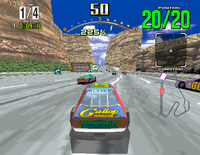 |
The advanced track, Dinosaur Canyon is as expected, more challenging in nature. The number of laps required has dropped to 4, and the number of cars to 20. Both the advanced and expert tracks are designed like more traditional racing games and are not based on NASCAR tracks. They also typically require the player to make heavy use of drifting in order to get around tight corners.
The music played on this track is "Let's Go Away", of which a shortened version is used as part of the attract mode. |
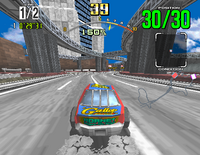 |
The expert track, Seaside Street Galaxy reduces the number of laps to 2 but raises the amount of oppoents to 30. As expected it is the hardest course in game and is the only track to contain mulitple paths (aside from the pit lane).
One of the sights of this track is a statue of Jeffry, a character from Virtua Fighter. Jeffry can be turned upside down by travelling in the wrong direction for more than two laps. Coming to a stop and tapping START ( The music played here is "Sky High", also known as "Blue, Blue Skies". |
Cheats
Daytona USA has a number of strange features and hidden options.
All music can be overridden in game by holding one of the VR buttons during the "Gentlemen start your engines" screen. VR1 plays "The King of Speed", VR2 plays "Lets Go Away", VR3 plays "Sky High" and VR4 plays the secret bonus track, "Pounding Pavement". The latter can be accessed in the Saturn game by holding ![]() on this screen.
on this screen.
Interestingly you'll still get time extensions for driving around tracks in reverse. Also, if you are off-road and stopped, pressing START will return you to the track.
Time attack mode can be enabled by holding START in the transmission select screen. Also by holding VR2, VR3 and VR4 at once, a secret fifth birds eye view is enabled.
Like some of Sega's other games, giving specific initials in the results screen will trigger jingle tracks from previous Sega titles:
| NAG | Virtua Racing | MAS | ??? | GOS | ??? | MIT | ??? |
|---|---|---|---|---|---|---|---|
| ARI | ??? | YAS | Virtua Racing | DEK | ??? | OSA | ??? |
| GOM | ??? | D.K | ??? | MAC | ??? | KAG | ??? |
| MIY | ??? | KEN | ??? | H.O | Hang-On | S.H | Space Harrier |
| O.R | OutRun | A.B | After Burner | P.D | Power Drift | V.R | Virtua Racing |
| V.F | Virtua Fighter | SHO | Super Hang-On | SMG | Super Monaco GP | G.F | Galaxy Force |
| R.M | Rad Mobile | S.C | Stadium Cross | EXN | F1 Exhaust Note | S.F | Strike Fighter |
| GLC | G-Loc: Air Battle | TOR | Turbo OutRun | ORS | OutRunners | GPR | GP Rider |
| F.Z | Fantasy Zone | E.R | Enduro Racer | SDI | SDI | QTT | Quartet |
| VMO | Vermillion | T.B | Thunder Blade |
Saturn Exclusive Cheats
"Karaoke mode" (i.e. show the lyrics of the music in game) can be enabled by using a normal number of laps, holding ![]() and selecting a track using
and selecting a track using ![]() .
.
"Maniac Mode" (depicted by a small "M" in the top-left hand corner of the screen) can be enabled by entering the code ![]()
![]()
![]()
![]()
![]()
![]()
![]()
![]()
![]()
![]()
![]() . This makes the opponent cars far more faster and agressive.
. This makes the opponent cars far more faster and agressive.
Japanese/PAL versions of the game use kph as a measurement of speed while the US version uses mph. This can be reversed by holding ![]()
![]()
![]() on controller 2 and pressing START on controller 1.
on controller 2 and pressing START on controller 1.
By far the most interesting addition to the game is the "horse", usually seen as part of the scenery. It can either be unlocked by landing in first place on every track, or by holding ![]()
![]()
![]()
![]() and
and ![]() on the title screen, then pressing START . The "automatic" horse is brown, while the "manual" horse is grey and both can travel as fast on grass as they can on tarmac. They also cannot take damage and so can use the pit lanes like normal roads. Other cars are unlocked along the way by finishing first on certain tracks.
on the title screen, then pressing START . The "automatic" horse is brown, while the "manual" horse is grey and both can travel as fast on grass as they can on tarmac. They also cannot take damage and so can use the pit lanes like normal roads. Other cars are unlocked along the way by finishing first on certain tracks.
"Saturn Mode" allows you to "officially" race tracks in reverse by holding START and selecting a track with ![]() .
.
Ports and Rereleases
Due to its popularity, Daytona USA was released as a western launch title for the Sega Saturn in 1995. This version, like the Sega Saturn itself, was rushed for a quick release and was widely criticised for its lower framerate (~20FPS) and numerous graphical concerns. The Saturn's draw distance is shorter, meaning that only the scenery close to the hornet is rendered, and suffers heavily from "clipping" as the game fails to disguise the problem (later Saturn games would use "fogging", which gives the impression that the world "fades out" when it reaches the end of the draw distance). The camera is considerably more jerky in some sections of the game also.
This was not seen as a good thing for the Saturn, as the PlayStation's port of Namco's Ridge Racer, released at a similar time, was neither rushed nor struggled to mask graphical concerns (it is also widely considered that the arcade version of Daytona USA is more technically advanced than the arcade version of Ridge Racer). These sorts of issues in early Saturn games gave users the impression the PlayStation was much better equipped to handle 3D worlds, which, in the west at least, was seen as the way forward for video games.
The Saturn version does include some enhancements however, such as the option to play as the other cars seen in the arcade version and the use of a higher quality CD audio soundtrack (Takenobu Mitsuyoshi re-recorded each song from beginning to end rather than splice clips around like in the model 2 version). It is compatible with the Arcade Racer Joystick and surprisingly, the 3D Control Pad (released a full year after Daytona USA). The game interprets the 3D Control Pad as an Arcade Racer Joystick when it is set to "analog".
A port of Daytona USA was also planned for the Sega 32X, but was cancelled presumably because of the add-on's failure to attract a large audience, or the limited graphics capabilities of the system.
In 1996 a Windows port of the game was released and is similar to the Saturn version. In an attempt to win back consumers, Sega would also release another version of Daytona USA in the same year - Daytona USA: Championship Circuit Edition. Like Sega Rally, this version was tuned up by Sega AM3 and offered a more stable framerate with more tracks and features.
Championship Circuit Edition would mark the first in a long line of sequels, which, with the exception of Daytona USA 2, simply took the formula of the original arcade game and "upgraded" it, rather than offering a brand new experience. Sega Racing Classic, released fifteen years after Daytona USA is even worse in this regard, as it is almost identical in nature bar some increased screen resolutions and missing Daytona branding.
Gallery
Screenshots
Model 2
- Result.png
Results
Model 2 Bootleg Versions
Physical Scans
| Sega Retro Average | ||||
|---|---|---|---|---|
|
| {{|L}} | N/A |
|---|---|
| Based on 0 reviews | |
Model 2 Version
Saturn Version
| Saturn, JP |
|---|
50x50px Disc |
Windows Version
| PC, US |
|---|
| <div style="margin:auto; max-width:Expression error: Unexpected < operator.px">
320x120px Cover
|
Promotional Material
- Daytona USA flier.png
JP flyer
